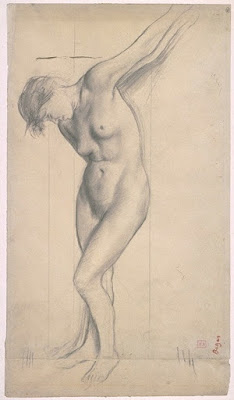 |
| Edgar Degas Study of Sash on Ballet Costume ca. 1887 drawing Musée d'Orsay, Paris |
 |
| Edgar Degas At the Milliner ca. 1882 pastel Musée d'Orsay, Paris |
 |
| Edgar Degas At the Milliner ca. 1895 pastel Musée d'Orsay, Paris |
 |
| Edgar Degas Woman Ironing ca. 1869 pastel Musée d'Orsay, Paris |
 |
| Edgar Degas Study of Édouard Manet ca. 1866-68 wash drawing (given by Degas to Manet) Musée d'Orsay, Paris |
 |
| Edgar Degas Study of Thérèse Degas Morbilli ca. 1865 drawing Musée d'Orsay, Paris |
 |
| Edgar Degas Seated Dancer ca. 1879 drawing Musée d'Orsay, Paris |
 |
| Edgar Degas Seated Dancer with Hand on Ankle ca. 1881-83 pastel Musée d'Orsay, Paris |
 |
| Edgar Degas Dancers ca. 1884-85 pastel Musée d'Orsay, Paris |
 |
| Edgar Degas Study for Misfortunes of the City of New Orleans ca. 1865 drawing Musée d'Orsay, Paris |
 |
| Edgar Degas Study for Misfortunes of the City of New Orleans ca. 1865 drawing Musée d'Orsay, Paris |
 |
| Edgar Degas Study for Misfortunes of the City of New Orleans ca. 1865 drawing Musée d'Orsay, Paris |
 |
| Edgar Degas Study for Misfortunes of the City of New Orleans ca. 1865 drawing Musée d'Orsay, Paris |
 |
| Edgar Degas Study for Misfortunes of the City of New Orleans ca. 1865 drawing Musée d'Orsay, Paris |
 |
| Edgar Degas Misfortunes of the City of New Orleans 1865 oil on paper, mounted on canvas Musée d'Orsay, Paris |
"What of poor Degas, who had assiduously copied the old masters (some 500 painted and drawn copies survive); who was a museum-blinded artist if ever there were one; who was struggling with Sémiramis and other history paintings in the early 1860s; and who was described by his father in November 1863 as 'our Raphael working always, but producing nothing finished, and the years are passing'. Indeed, the years were passing, and two more were to pass before he first exhibited at the Salon of 1865."
"The catalogue of that Salon gave his name as Edgard De Gas. He did not list a master: it was usual to say pupil of so-and-so. An act of independent defiance? Degas, at the age of 21, standing on his own artistic feet? The title Scène de guerre au moyen age, doesn't tell us very much. Most other entries gave a precise title and a quotation, sometimes tediously long, from a literary or historical source. But Degas the Independent gave none. The medium was described as pastel; and no sizes were given."
"Now consider the title of a picture that was included in the sale of Degas' studio after his death: Les Malheurs de la ville d'Orléans. It was signed Ed de Gas; the medium was described as 'peinture à l'essence (papier reporté sur toile)'; and, finally, the size was given as 83 x 145 cm (in other words, roughly 3 x 5 feet). Is this the same picture that Degas exhibited at the Salon of 1865? It has always been assumed so. But as yet not one Salon review has been discovered that would clinch the identification."
"Degas's Salon title is very general. Scène de guerre au moyen age; a scene of fire, devastation, murder and rape. But at this studio sale, some fifty years alter, it was more specific: Les Malheurs de la ville d'Orléans – the misfortunes of the town of Orleans. So periodically since 1918, critics have searched feverishly for a literary source, either a late medieval chronicler or a nineteenth-century historian. But nothing has turned up – nothing, that is, that carries conviction."
"However, in 1967, Mme. Hélène Adhémar proposed an ingenious solution. X-Rays of the picture appear to show that some kind of 'modern' costume once existed in the horseman. And Mme. Adhémar proposes that the entry in the studio sale catalogue should have read: Les Malheurs de la Nouvelle Orléans, not 'de la ville d'Orléans'. In other words, this picture could have begun as a modern allegory on the American Civil War in Louisiana, and especially in New Orleans where Degas' maternal relatives lived. And his aunt and his two female cousins came to Europe to escape the atrocities of the War. The only problem is that none of the surviving drawings gives any indications of modern dress."
"There are some three dozen of these preparatory drawings. The horseman shooting the arrow, for example, Degas first drew in the nude, and then clothed in the most reputable academic manner. And they exist for all the nude figures, giving the picture that air of a demonstration piece of the painting of the nude."
– Ronald Pickvance, from Degas and the Painting of Modern Life (Society of Arts Journal, April 1980)